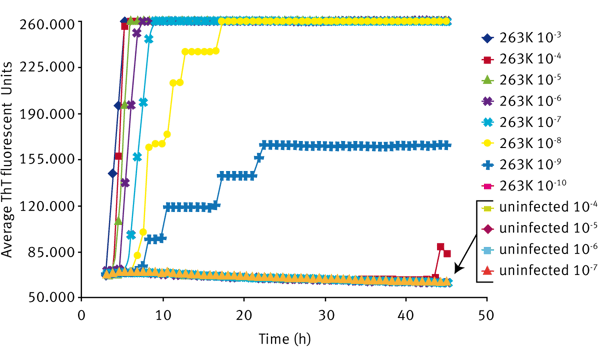Introduction
Prions are transmittable pathogens that cause an abnormal folding of a brain protein in both humans and animals. Infection results in brain damage and is fatal. Some examples of these neurodegenerative diseases are Scrapie, Bovine Spongiform Encephalopathy, and Creutzfeldt-Jakob Disease.
Previously, prions were studied using lengthy bioassays where infected animals were studied over long periods of time (1-6 months). This was both time consuming and costly to maintain the infected animal. Researchers at Rocky Mountain Laboratories in Hamilton, Montana have developed a new prion seeding assay called Real-Time Quaking Induced Conversion Assay (RT-QuIC) that gives end point quantitation for measuring the levels of prions in infected samples. This assay is both faster and a higher throughput compared to previous methods. The assay can be completed in as short as 20 hours and is as sensitive, if not more so, than whole animal models.
BMG LABTECH’s Omega series of readers have the ability to shake and incubate microplates over long periods of time. RT-QuIC samples were measured every 15 minutes for 20-68 hours while alternately shaking for a minute and resting for a minute. A software script was developed to control the periods of shaking and resting needed to activate the assay.
Assay Principle
Combining parts of the original Quaking Induced Conversion (QuIC) assay and the amyloid seeding assay (ASA), the RT-QuIC assay is used to estimate the relative amount of prion seeding. The assay measures serial dilutions of samples, statistically estimating the seeding dose (SD). In the assay, very small amounts of infectious prions are added to normal prion protein to seed or cause the misfolding of the prion proteins as seen in the disease. The assay is quantitated by measuring serial dilutions of the samples and determining the loss of seeding activity (SD50), which is the end point dilution.
Materials & Methods
- Nalgene Nunc black with clear flat bottom
- 96 well plate
- Nalgene Nunc plate sealer film
- FLUOstar® Omega, BMG LABTECH
Experimental
The instrument was set to incubate at 42°C for the entire 20-68 hour period. A script was created to use two test run protocols. One protocol was set to shake the plate for one minute and rest for one minute. The second protocol was set to take a fluorescence endpoint measurement using the bottom optic every 15 minutes. The fluorescent dye thioflavin T (ThT) is used as a prion seeding marker. When ThT is added to recombinant prion proteins, it becomes incorporated when polymerization occurs causing an increase in fluorescence over time.
Instrument settings
| Fluorescence endpoint - Bottom Reading | |
| Excitation filter: | 450nm |
| Emission filter: | 480nm |
| Flashes: |
20
|
| Gain: |
2000
|
| Shaking: |
700RPM Double Orbital
|
Analysis
A Spearman-Kärber analysis, analogous to a bioassay’s lethal dose of 50% (LD50), was used to estimate a seeding dose or dilution at which 50% of the wells became ThT positive per gram of tissue (SD50/g). For Spearman-Kärber analysis a dilution series with at least one dilution giving 100% ThT positivity and at least one dilution giving 0% ThT positivity was chosen.
Results & Discussion
A software script was used to measure RT-QuIC assays for 20-68 hours. Data was collected as an average of relative fluorescence units over 8 replicate wells. Only data for every 45 minutes is shown in each figure.
BMG LABTECH’s Omega series of plate readers are able to shake in a unique double orbital pattern in addition to linear and orbital. For incubation the temperature was maintained at 42°C over the entire measurement period. The high quality design and manufacturing of the Omegas allow researchers to measure continuously for days at a time without a break in shaking or temperature fluctuations. Data was collected without interruption and outputted to BMG LABTECH’s data analysis software (MARS) and Excel.
Figures 1 and 2, show the RT-QuIC assay as it relates to hamster scrapie brain homogenates (BHs). Figure 1 used hamster BHs that were harvested 80-85 days post inoculation (DPI), whereas figure 2 used hamster BHs that were harvested 10 days post inoculation.
The 50% seeding dose (SD50) is defined as the amount giving sufficiently enhanced ThT fluorescence in half of the replicate wells. In this case, the approximate SD50 was achieved with a 2 μl aliquot (the seed volume) of a 10E-9 dilution of the scrapie BH stock (dark blue line). Thus the Spearman-Kärber estimate for the SD50/2μL is 10E9.1 and for the SD50/g is 10E12. The log of this SD50 (~11) corresponded well with the log of the LD50 (~10) found in the bioassay.
In this case, the approximate SD50 was achieved with a 2 μl aliquot (the seed volume) of a 10E−5 dilution of the scrapie 10dpi 263K BH stock (green line). This gave an SD50/2μL of 10E5.5 and an SD50/g of 10E8.2.
As expected, the SD50/gram of tissue for the 85 DPI samples (10E12) was higher than the 10 DPI (10E8.2) because it had a longer time for onset. These RT-QuIC results correlated well with bioassay results. This data shows that the RT-QuIC assay could be considered a faster, higher throughput alternative to whole animal bioassays. This also shows that animals as early as ten days post inoculation can be examined using this assay.
Conclusion
Prion seeding can be measured faster and in a higher throughput using the RT-QuIC assay and a microplate reader. Some of the transmissible spongiform encephalopathies that have been shown to work using RT-QuIC include hamster and sheep scrapie, deer chronic wasting disease, Creutzfeldt-Jakob Disease (CJD), and Bovine Spongiform Encephalopathy (BSE). This assay is both faster and more sensitive than past bioassays. The Omega series of plate readers from BMG LABTECH are both functional and robust to withstand the many days of shaking at high speeds required for this assay.


